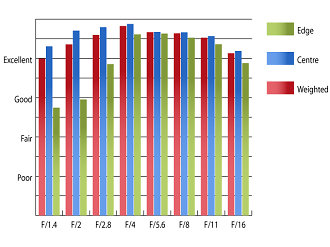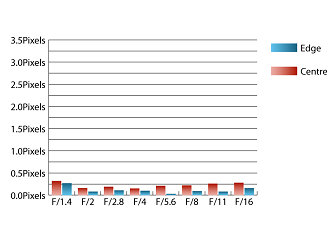Zeiss Otus 85mm f/1.4 ZF.2 Lens Review
Zeiss Otus 85mm f/1.4 Performance
Sharpness in the centre of the frame at maximum aperture is already excellent, with fairly good sharpness being recorded towards the edges of the frame. Stopping down improves performance across the frame, only slightly in the centre, but drastically towards the edges of the frame. As a result, outstanding sharpness is realised from edge to edge between f/4 and f/11.
How to read our charts
The blue column represents readings from the centre of the picture frame at the various apertures and the green is from the edges. Averaging them out gives the red weighted column.The scale on the left side is an indication of actual image resolution. The taller the column, the better the lens performance. Simple.
For this review, the lens was tested on a Nikon D600 using Imatest.
Levels of chromatic aberrations are extremely well controlled, only just exceeding a quarter of a pixel width towards the edges of the frame at maximum aperture. You will be hard pushed to notice this low level of fringing at all.
How to read our charts
Chromatic aberration is the lens' inability to focus on the sensor or film all colours of visible light at the same point. Severe chromatic aberration gives a noticeable fringing or a halo effect around sharp edges within the picture. It can be cured in software.Apochromatic lenses have special lens elements (aspheric, extra-low dispersion etc) to minimize the problem, hence they usually cost more.
For this review, the lens was tested on a Nikon D600 using Imatest.
As you may expect from a fast aperture lens, falloff of illumination towards the corners is quite pronounced. At maximum aperture the corners are 2.41 stops darker than the image centre and visually uniform illumination isn't achieved until stopped down to f/4 or beyond.
Distortion is negligible. Imatest could only detect 0.18% barrel distortion, which will be incredibly difficult to spot and should never require correction.
So far so good, but one issue with this lens' optics did surface that is worth mentioning. Out of focus highlights, which are all-important on a lens like this appear to show marks that may be from the way aspherical elements in the lens are produced. These marks sometimes show as concentric rings or lines, spoiling what would otherwise be perfectly rendered out of focus highlights. You'll not notice this issue photographing test charts, but it will soon become annoying in portraits and other areas of photography requiring the shallow depth of field you get at f/1.4. As aspherical elements are commonplace nowadays, this phenomenon isn't unheard of, although it is a shame to see it appearing in a lens that costs this much.
As you might expect from a Zeiss optic bearing the red T* nomenclature, contrast holds up very well indeed, even when shooting into the light. A huge metal circular hood is supplied with the lens, which does a great job of shading the lens from extraneous light that may cause issues.
Value For Money
Being priced at over twice the price of any 85mm lens from Canon or Nikon, including Canon's 85mm f/1.2L II USM lens, talking about value for money with this lens seems churlish, if not completely pointless.
There will be people who are more than happy to stump up the cash for this lens due to the Zeiss name and reputation that goes with it, just as there are people who will buy a Bentley, or Japanese cold-folded steel kitchen knives. To these people, this lens will probably represent as good value for money as their other luxury goods. However, the average photographer may be able to find other ways to spend their money.
Add your message
Please login here or if you've not registered, you can register here. Registering is safe, quick and free.
photodo Stats
428 MTF tests
74 in-depth photodo reviews
100+ users join each day
Help the lens community by reviewing or rating a lens today via our lens search
Latest Lens Reviews
- Chinon 28mm f/2.8 Vintage Lens Review
- Canon EF 70-200mm f/4L IS II USM Lens Review
- Samyang AF 85mm f/1.4 EF Review
- Sigma 70mm f/2.8 DG Macro Art Review
- Samyang AF 24mm f/2.8 FE Review
- Meike 50mm f/1.7 Review
- Tamron 70-210mm f/4 Di VC USD Review
- Lensbaby Burnside 35mm f/2.8 Review
- Asahi Super Takumar 50mm f/1.4 Review
- Asahi Super-Multi-Coated Takumar 135mm f/3.5 Review


